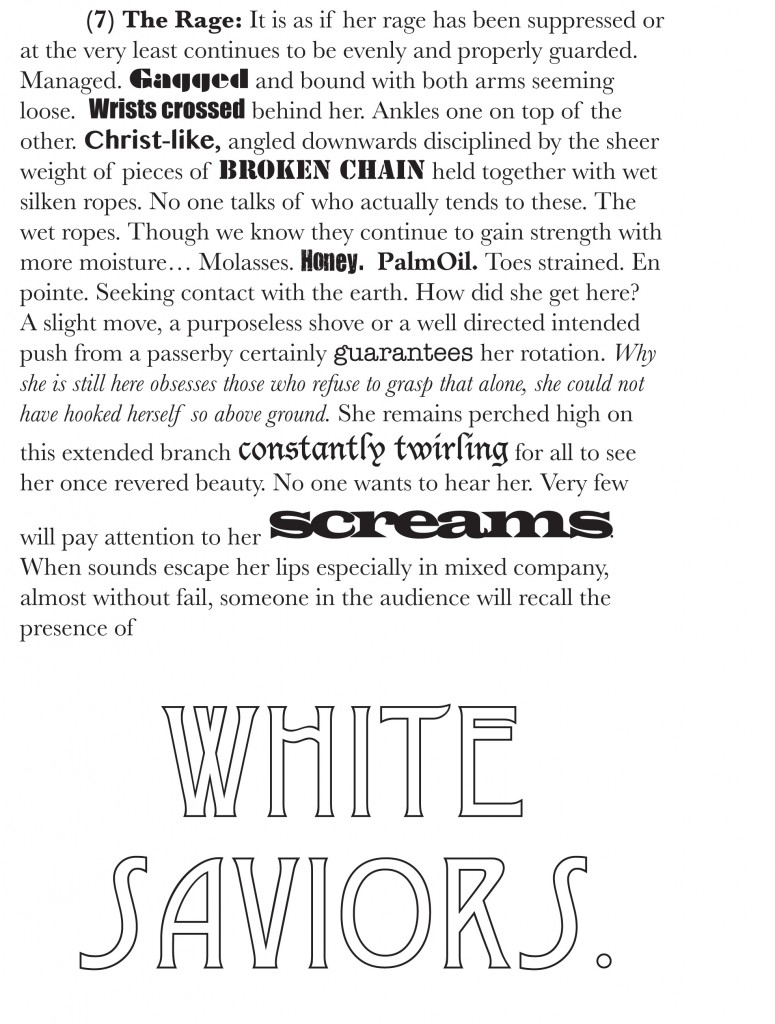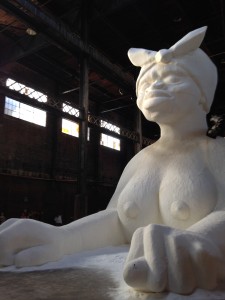
A recent installation of Kara Walker’s “a Subtlety, or the Marvelous Sugar Baby” prompted anthropologist Elizabeth Chin to approach Anthropology Now with a powerful idea for commentary. With the former Domino Sugar Refinery as the exhibit space and evocations of Sidney Mintz’s Sweetness and Power as one of many shared points of reference, we invited several anthropologists who viewed the work during its May 10 to July 6 run in Williamsburg, Brooklyn to share thoughts with our readers. They responded to the sculpture, its reception by the general public and its representation by the arts establishment in a story by Times art critic Roberta Smith (linked below). Dána-Ain Davis, Gina Athena Ulysse, Antoinette Jackson, Yarimar Bonilla and Elizabeth herself engaged the topic with powerful, poetically spare commentaries and/or original photos.
We want to help keep this type of conversation going by providing a platform where anthropologists can write confidently about current topics in styles that have reach. We seek short, op-ed style or creative pieces that elaborate on archaeological, biological, cultural or linguistic themes in the news. Our goal is to offer insightful analysis that also provides a strong model for anthropologically-informed commentary in a short format, written on a tight deadline. If you would like to initiate a Reach discussion, please submit a 50-word prospectus and a link to the original news piece to vesperi4anthronow@gmail.com
— Maria D. Vesperi, General Editor
Sugar? Sure, but Salted With Meaning
by Roberta Smith, May 11, 2014, New York Times
“With her stinging, site-specific installation at the former Domino Sugar compound on the edge of the East River in Williamsburg, Brooklyn, Kara Walker expands her imposing achievement to include three dimensions and monumental scale. In the process, she raises the bar on an overused art-spectacle formula as well as her own work. And she subjects a grand, decaying structure fraught with the conflicted history of the sugar trade and its physical residue to a kind of predemolition purification ritual.”
Continue reading Roberta Smith’s piece in the New York Times here >
~~~*~~~
Words from Dána-Ain Davis
june 6, 2014 waiting to see a subtlety by kara walker
my friend jill and i decided to see the kara walker exhibit back in may. seeing walker together is our ritual. when we go people get annoyed with us, because we are loud when we see kara’s work. we are loud because her work is loud and since we know her work is about us, as black women, we feel entitled to be loud too.
3:21 – i leave home, take g train to the metropolitan – grand street stop. i have never been to this part of williamsburg by train and have no sense of how far it is from kent and s. 1st street.
3:52 – i exit the train and it is so hot i am disoriented, sweaty, and the air sticks to me like prickly pods in the fall. “just get there” i think to myself, jill will be there and we’ll be relieved to be in the company of our sugarmama, sugarbaby, sweet thing.
4:26 – i am still not there, still walking. jill is lost
4:51 – i arrive. there is a line 3 blocks deep
5:04 – no jill
5:56 – the long line creeps and when we get to clearing near the entrance we have to fill out a release form, acknowledging we are on a construction site. finally i confront the domino sugar factory and a sign reading:
a Subtlety
the beauty of the letters is clumsy against the decaying building with broken windows
the walk to the entrance is long and feels like walking gangplank. my stomach is in knots, nervous i suppose because i have no idea what to expect. every time i see a kara walker exhibit, i laugh uncontrollably because she manages to so accurately depict what if feels like to be a black woman in amerika and i am amused that most people limit her acumen to art. jill and i view it as biography
i am also afraid i will want to lick the sugar, i am addicted to sugar. really. i used to eat it by the ½ cup with butter and a little flour and some lemon juice. i am afraid i will relapse.
6:00 – as i get closer to the door, nausea overcomes me from the old caked on sweetness of so many years.

when i enter i turn to the right and immediately see her in front of me, but am preoccupied by the burnt sugar on the walls and shiny young life-size boys made of molasses with big heads holding baskets. they look as if they are crying. my mind is flooded with images of sugar plantations; of people falling into vats of boiling cane, of burnt skin from high heat. i wonder how many people died here on/for this plantation…the domino plantation.

i fear getting too close…there are things i don’t want to see – people sticking out their tongues as if they are licking her nipples or placing their fingers near her vagina….so I take my time. sugarmamasugarbabysweetthing
6:08 – courage ushers me near her right hand and i listen as one of the volunteers explains exactly how she is made…from styrofoam coated in tons of sugar. the technology of her existence distracts me from her whiteness, from people’s laughter; from the fact that she is only half the size of a sphinx; from her huge nipples, her power, her enemies, her oppressors. sugarmamasugarbabysweetthing
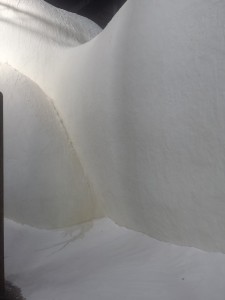
Close-up of the curves of HER from the Kara Walker exhibit “a Subtlety, or the Marvelous Sugar Baby”. Photo by Dána-Ain Davis.
i have no idea what time it is – i make my way to her right side. i cannot stop staring at the crease of the fold where her thigh and her belly meet. sugarmamasugarbabysweething
i move around to the rear where her vulva daringly greats visitors. her feet are turned in, a place on which she rests her haunches…feet that might kick someone or be her way out of there… child’s pose
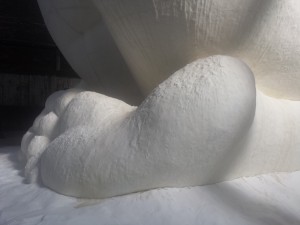
people are staring and taking photos of her vulva –she is the contemporary saartjie bartmann
i am done. no laughter this time. wearily i walk to her left side and sit on a bench. one tear slides down my right cheek afraid to be followed by others. only one. oh the pain and joy kara has left me to contend with.
6:18 – finally jill arrives. i am relieved for i have barely exhaled. we go through the exhibit all over again. this time thinking i am more prepared, i guide jill through the exhibit hoping no tears will fall. a few come of their own accord as the sun sets.
sometime before closing – time to go. looking up one last time, she looks regal and worn out. i do want to take her with me, somehow melt her, so people can’t see us anymore.
 Dána-Ain Davis is Associate Chair, Graduate Program in Urban Studies at Queens College and serves on the faculty in the Ph.D. Program in Anthropology at the Graduate Center, City University of New York. Her work focuses on how people live and are interpreted through, policy and ideology, specifically neoliberalism. She is the author or co-author of three books: Black Battered Women and Welfare Reform: Between a Rock and Hard Place (2006); Black Genders and Sexualities with Shaka McGlotten (2012); and Feminist Activist Ethnography: Counterpoints to Neoliberalism in North America with Christa Craven (2013).
Dána-Ain Davis is Associate Chair, Graduate Program in Urban Studies at Queens College and serves on the faculty in the Ph.D. Program in Anthropology at the Graduate Center, City University of New York. Her work focuses on how people live and are interpreted through, policy and ideology, specifically neoliberalism. She is the author or co-author of three books: Black Battered Women and Welfare Reform: Between a Rock and Hard Place (2006); Black Genders and Sexualities with Shaka McGlotten (2012); and Feminist Activist Ethnography: Counterpoints to Neoliberalism in North America with Christa Craven (2013).
~~~*~~~
An Alter(ed)native by Gina Athena Ulysse
Introduction
She shall wait for history, but it will not absolve her….
(7) The Rage is an excerpt from “VooDooDoll What if Haïti Were a Woman: On Ti Travay sou 21 Pwen Or An Alter(ed)native in Something Other than Fiction.” Transition Issue 111 (2013)
Gina Athena Ulysse is associate professor of anthropology at Wesleyan University in CT. A poet, performance and multi-media artist, she is the author of Downtown Ladies (Chicago 2008) an ethnography of Jamaican Informal Commercial Importers, and Why Haiti Needs New Narratives: A Post-Quake Chronicle (Wesleyan 2015). Her first installment from VooDooDoll, What if Haiti Were a Woman: On ti Travay sou 21 Pwen—a performance-installation project had its debut at IX Encuentro in Montréal in June. Her recent work has appeared in: E-misférica, Anthropology Now, Gastronomica, and Souls.
~~~*~~~
Words from Antoinette T. Jackson
Kara Walker’s Installation—“The Marvelous Sugar Baby”
A Sunday Visit
HER Face — I am a Black Woman’s face, gazing out and over you, this factory, and everything that came to bring me to this moment of shocking reminder of what brought sugar from the Caribbean to New York City and whose body and labor made it possible.
Awareness and Anticipation. The anticipation of seeing Kara Walker’s piece began when I first read about it in the New York Times in April. I knew the moment I saw the enormity of the Mammy headed statue covered in sugar and the ‘in your face’ power of HER, that made me look— that I wanted to go.
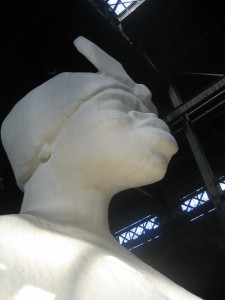
The Significance. As a black woman, I have found that there are seldom national stories of historical import and critical insight about black women that find themselves in mainstream press and part of a you must go see this now sort of buzz. This is how I came to see HER, to hear of HER, as in the statue, the installation called “A Subtlety” by Kara Walker. Later I started hearing about her everywhere, particularly in academic circles and especially amongst long-term followers of Kara Walker’s work.
Going to HER. So I went to see HER on the final day of the installation, a Sunday afternoon in July. There were four of us—my partner and I and two friends, both of whom identified as white.
.
The Line. When we arrived there was a long line. We entered the line about 8-10 blocks away from the entrance. The crowd was relaxed and the line moved steadily. Like others in line we chatted and tried to stay cool and hydrated. We also tried to glean something from the faces of those we assumed to be returning from the exhibit as they paraded pass us.
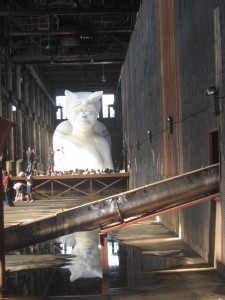
Distractions. In the line I was excited but distracted by the sights of Williamsburg and the clash of old factories and new high priced high rises with many amenities; by surrounding conversations and the range of people in line around us. A bike path ran right next to the line and sometimes bicyclists streaming by the line heading in the opposite direction from where we were going nearly clashed with those we thought to be returning from the installation. These clashes disrupt the calmness of the line, with one clash resulting in a bike rider yelling out, “get out of my way you bitch” to a passing walker. My partner became annoyed when I mentioned that I heard one of the cyclists say, “it’s a giant sphinx made of sugar”—possibly in response to a question posed by another rider about the long line. A debate with another member of our group erupted about what the rider meant or should have said. One our friends wanted a quick tutorial on how to look at the exhibit because she was unfamiliar with the details of the transatlantic slave trade, the African diaspora, and the Caribbean sugar trade in particular. She even confessed that she was unfamiliar with Sidney Mintz’s book—Sweetness and Power but had dared to come anyway, to learn something from a direct experience with the installation. The final distraction was a vendor that decided to incorporate the marketing language for the installation into his sales pitch for drinks and other sweet treats— calling out “one of a kind Caribbean sugar treat”, “rare sweet”, and “last day”.
Signing the Release. Finally about a couple blocks before the entrance we were given release forms to sign. When someone asked what the release was for, we were told that it was because we were entering a construction zone. My immediate thought had been that the release form was to protect Kara Walker because her installation may be too provocative and make sure you understood that you entered at your own risk of being too challenged or too stimulated.
Enter Here. As you enter the final gate and head toward the factory door, there are signs telling about the Installation and pictures and warnings about what you can and cannot do once inside the Installation. Then you are asked to put your signed release in a box and are directed inside the factory. Just before you see HER, there is a clear warning, “refrain from licking or touching”.
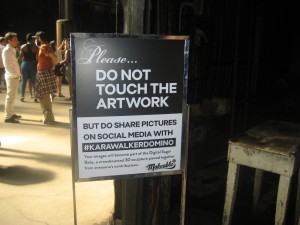
Seeing HER. She stands about 100 yards away from the door, towering in clear view of your arrival. She waits silently taking it all in, looking as each visitor enters even as her sugar veneer melts down from all her days of holding court. Her all white domino colored sugar self creates a glare. But I don’t look away and immediately start taking pictures. As I move, my foot sticks to the floor in some spots and I hear the sound this makes under my shoe. There are people everywhere and everyone is taking pictures or filming or asking questions of the staff positioned around HER. Parents urge their children forward toward her and the young ones seem hesitant but they definitely see HER, see this bigger than the biggest Easter Bunny sized piece of candy dipped in white sugar. What is this giant woman that smells like candy and sugar? It is intense and they move slowly their reasons different from mine. I make my way closer to within about 20 feet and watch as people gather in front of her large breasts and between her extended sphinx-like poise. They are pointing, talking, filming, and taking pictures of her and themselves up close and familiar.
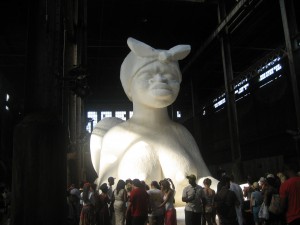
I move from the front to the side but am not prepared for the back. All the photos I have seen have been of the front but it is her backside that is arresting—her huge hips, buttocks, feet, and vulva all clearly visible and completely exposed. There are less people on this side and some point to her vulva, others to her large feet, and others like me look at the sheer size of her from this end.
Exit Here. As we exit, I think that our friend was right to come and learn from this black woman’s body— this giant sphinx made of sugar— sweetness and power indeed.
Reflection of HER. The human cost of the slave trade, black bodies, and the making of wealth and pleasure for white bodies has often been masked or under exposed. However, this installation exposes a black woman’s breasts and pronounced face and features; it exposes stories carried in hips; aches and pains embedded in feet, and the many children and many histories birthed without consent. It is the lived experience of a black woman who has seen some things that is on full display in a sugar factory in Brooklyn. Those who dare to look at HER full body, front and back, see the story of sugar as the end of a long journey that began with her body and ends here with her body again performing a service.

 Antoinette Jackson is associate professor of anthropology at the University of South Florida in Tampa. She is interested in identity and representation at public sites of history and heritage. Antoinette’s most recent book is Speaking for the Enslaved: Heritage Interpretation at Antebellum Plantation Sites (2012).
Antoinette Jackson is associate professor of anthropology at the University of South Florida in Tampa. She is interested in identity and representation at public sites of history and heritage. Antoinette’s most recent book is Speaking for the Enslaved: Heritage Interpretation at Antebellum Plantation Sites (2012).
~~~*~~~
Words from Elizabeth Chin
The Spectacle is Us
In A Subtlety, Kara Walker crystallizes the spectacle of race in a monumental assertion of whiteness as blackness. Or is it blackness as whiteness? Unable to get to New York to see it in person, I was left to experience this event as one that leaked out well past the confines of the Domino factory itself. Hashtag and instagram; blog posts and vimeo. Early on I keyed into the waves of anger voiced by people of color who were incensed to see tasteless (so to speak) posts in which visitors appeared to pinch her nipples or lick her vagina. What is the responsibility of the artist? Many seemed to be asking for educational materials that somehow would have prevented people from responding in such a manner. While not charmed by the ugly responses, I do not hold Kara Walker responsible for them. For me –from afar—it seems that these responses are quite simply, more of the same. The same racist and sexist stuff that happens every day and all the time. The monumentality and singularity of the exhibition merely extract it in concentrated form. Of course it bothers me that people do these things, but I certainly would hardly expect people who don’t respect women or people of color in their everyday lives to suddenly become reverential when coming into contact with the very things they cannot deal with when they are towering above them, making them small, she might as well have given her the face of Condoleeza Rice…it’s not about you, it’s about them: their performances of how stuck they are. That’s the spectacle. It does hurt to stand there, to witness the shamelessness of it. But no amount of in situ educational material could ever hope to make a dent. Even more: what it shows is that even those who THOUGHT they were going out of respect couldn’t quite keep themselves in check. Oops, my racism slipped out! Whoops, there goes my sexism! But is there no way to have a lightness to the encounter – is there nothing even darkly funny to explore? Her breasts are, after all, mightily airborne, in a way at once aggressive and absurd. and her swooping buttocks have an epicness to them that verges on the cartoonish. She has not even the slightest hint of cellulite. This is not about reality, but about the cooked down to its essence-ness of race in our history and the way that history flows through our daily lives whether we want it to or not. In the end, the spectacle is us, trapped like flies in syrup, in the huge, encompassing lie that is race.
Elizabeth Chin joined the faculty of Art Center College of Design in 2011 as a founding member of the Media Design Practices/Field program. As an anthropologist her practice includes performative scholarship, experimental writing and collaborative ethnography. Her book Purchasing Power (Minnesota 2001) was a finalist for the C. Wright Mills Award.In 2007 she won the AAA/Oxford University Press Award for Excellence in Undergraduate Teaching of Anthropology.
~~~*~~~
Vantage points from Yarimar Bonilla
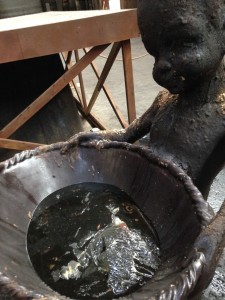
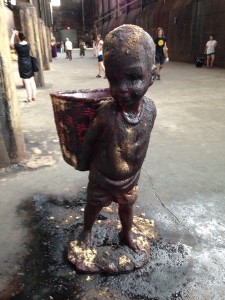


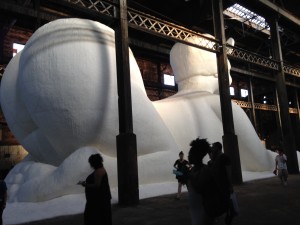
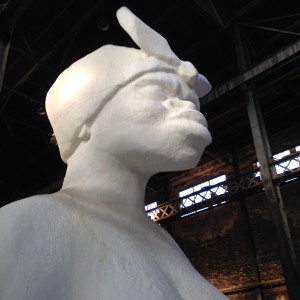



 Yarimar Bonilla is assistant professor of Anthropology and Caribbean Studies at Rutgers University, where she is also on the Advisory Board for the Critical Caribbean Studies Initiative and the Institute for Research on Women. She teaches and writes about social movements, political imaginaries, colonial legacies and historical memory in the non-sovereign Caribbean.
Yarimar Bonilla is assistant professor of Anthropology and Caribbean Studies at Rutgers University, where she is also on the Advisory Board for the Critical Caribbean Studies Initiative and the Institute for Research on Women. She teaches and writes about social movements, political imaginaries, colonial legacies and historical memory in the non-sovereign Caribbean.



